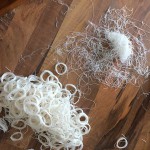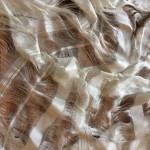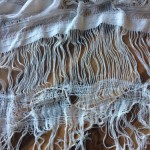Erin Manning | La couleur du temps
TITLE: La couleur du temps
WORK: An odour of colour, a touch in the gaze, a taste in the texture. What is this quality that exceeds the first approach of an object, the quality that moves through the form of an object but pierces experience, opening the object to its force? How to speak of the duration that radiates beyond the object? How to touch the becoming-work of the work, its implicit movement?
An object can never be fully determined. Not only because the object resists a generalized perception of itself – its transversality cannot be reduced to the experience of a single witness – but because the object also carries with itself the colour of time: it overflows category, altered by every encounter.
The object is never completely itself. It is relationnal, ecological. It participates, as Isabelle Stengers might say, in an ecology of practices. It gives sense back, gives direction, to the ecologies with which it co-composes.
This description of the object opens itself to the concept of the minor gesture. The object vibrates with potential minor gestures. These minor gestures are what invite the object to open itself toward its transformation, toward its internal variation.
What I propose for Dream City is a minor gesture that orients the colour of time. This minor gesture will be activated by a practice in time that will have started during my time in Tunis in April 2017.
During the 10 days I spent in Tunis in April in search of weavers, I found myself in a ritual of commerce. Silks, after all, spawned a commerce that oriented navigation for centuries, creating geographies of exchange. While the commerce as it was known during the period of the silk road is almost nonexistent today – due to industrialization and the prevalence of synthetics, which are far less costly –there is no question that the negotiation for the purchase of silk remains today a capitalist gesture. And so to travel to one of the sites of the earlier trade, and to seek out the few weavers left in order to purchase silk, would have to be seen as a gesture of capital.
Whereas my earlier work Threadways focused on ubiquitous mass-produced industrial textile and sought to explore the paradox of subtraction in the context of neoliberal capital, the Tunisian project of seeking out hand-loomed silks and cottons arguably placed me back squarely in the marketplace. Rather than resisting this gesture, I became curious about it. What can an economic exchange produce in the context of an artistic process?
What touched me in the medina of Tunis, where the majority of commerce circulates around products from China, was the quality of the encounter with the few remaining weavers. The commerce took place in time – the time of the encounter, the time of communication across languages, the time of touching the textile, of feeling its weave. The time of sharing a glass of tea and of discussing the veil to be worn by the bride. The time of speaking of my own work, and of the richness I sense so profoundly regarding the production of the weave, the handiwork, the tradition. And the surprise of my contemporary gesture, the madness of pulling the thread, of unweaving the textile.
This commerce contains an alter-economic dimension. It proposes a mode of encounter that touches the creation of a certain kind of value. Together we share the recognition that these almost lost arts are of enormous value. No question of negotiating the price. There is no price that would be right. And so we barely speak of price. We speak instead of my return, of my project. We speak of the quality of the thread, of the colours. I buy two silks, each woven by a different older man, one of the 5 remaining weavers in Tunis, and one cotton, this one woven outside the medina sold next to the Zitouna mosque where there are still a few tourists. I receive a gift. Because finally this professsion cannot be bought, or sold. It will persist only through a care for what is beyond the object itself, the colour that it will give to time.
I left Tunis the 17th of April 2017 to continue the exploration of time at the Bauhaus, in Weimar, where one of the most important textile artists began her work – Annie Albers. Her words are the ones I hear: textile, says Albers, is the first architecture. It is what makes home possible. The art of textile is what can never be perceived as an object as such. It is what gives space quality of form.
This work in time continues until October. Every day I work with the three textiles. Measuring 2.4 meters by 2 meters, these are large, almost square pieces. The work is long and repetitive. I pull the threads, always on the warp, and once the textile loosens, once it can barely hold its shape, I give it back its spine by reinserting its own threads, threads dyed using a Tunisian turmeric. The colour of the threads shifts with the natural mordants I use when I mix the spice into dyes. The smell with the variations in colour mark a synesthetic differential that moves through the textile.
This is patient work that creates its own choreography, its own dance. The aim is not to control the textile but to move with it, following its own tendencies. This sensation of working from the thread itself is carried by a desire to follow a process that unfolds in time. The gestures that emerge are influenced by the contours of the medina, by the geometries of its tiles, by its dizzying pathways. And by the movements of Weimar, the time of its own textile history which haunts me as I pull the threads. The textile in its slow unweaving holds the memory of all these durations, of the sense of direction proposed in the pulling. It is this colour of time that will return to Tunis in october 2017.
Upon arrival in Tunis, the three textiles will be hung. They will occupy almost the full width of the site such that the participant will inevitably be touched by them when walking through. There will be two wood benches, installed on the two ends of the passageway. Below each textile, there will be a small aluminium pot. Each pot will be filled with one of the spices, reflecting the dyeing of the threads. A few threads will hang in each pot. Water will be added to the spices in the pot each day and the textile will be sprayed to facilitate the colour leaching up the threads. The colour of time will become scented by one of the odors, one of the mixtures, of the medina.
The textiles will take the colour at the same time as they become more supple – the spraying will give the textile a certain weight. Slowly, we will feel the effects of gravity, and with them, the effects of the environment – the sun, the wind, the falling of the night.
Minor gestures can neither be created nor measured in advance. Even if there in potentia, they often remain unactivated. It is impossible to know today how and whether minor gestures will propose themselves within the framework of Dream City. What The Colour of Time offers is a mesh curtain that will perhaps know how to gather what too often remains imperceptible, and, by extension, devalorised. If there is value in this project that aims to touch the texture of time, it will be a value discovered in the complex ecology of practices that invent themselves, day by day, in the medina itself. Because this work does not exist to reenliven a past that is becoming lost but to celebrate what vibrates beyond experience as we know it, to celebrate what can never fully be discerned by the gaze that seeks to categorise existence.
AUTOR
Erin Manning
Dream City, Tunis Octobre 2017
http://erinmovement.com/la-couleur-du-temps/
Erin Manning holds a University Research Chair in Relational Art and Philosophy in the Faculty of Fine Arts at Concordia University (Montreal, Canada). She is also the director of the SenseLab (www.senselab.ca), a laboratory that explores the intersections between art practice and philosophy through the matrix of the sensing body in movement. Her current art practice is centred on large-scale participatory installations that facilitate emergent collectivities. Current art projects are focused around the concept of minor gestures in relation to colour, movement and participation. Publications include Always More Than One: Individuation’s Dance (Duke UP, 2013), Relationscapes: Movement, Art, Philosophy (Cambridge, Mass.: MIT Press, 2009) and, with Brian Massumi, Thought in the Act: Passages in the Ecology of Experience (Minnesota UP, 2014) and The Minor Gesture (Duke UP, 2016).
MANNING, Erin. Erin Manning | La couleur du temps. ClimaCom – Cosmopolíticas da Imagem[online], Campinas , ano. 4, n. 10. Nov. 2017 . Available from: https://climacom.mudancasclimaticas.net.br/?p=7974
SEÇÃO ARTE |COSMOPOLÍTICAS DA IMAGEM |Ano 4, n. 10, 2017
ARQUIVO ARTE |TODAS EDIÇÕES ANTERIORES






